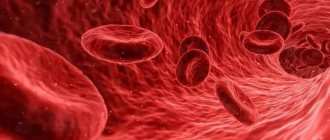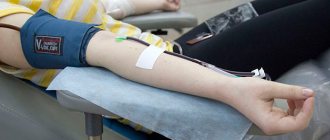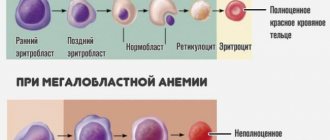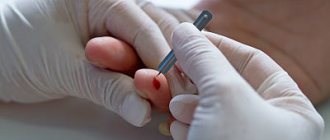Blood donation (from the Latin donare - “to give”) and (or) its components is the voluntary donation of blood and (or) its components by donors, as well as activities aimed at organizing and ensuring the safety of the collection of blood and its components. Blood taken from a donor (donor blood) is used for research and educational purposes; in the production of blood components, medicines and medical devices. The clinical use of donor blood and (or) its components is associated with transfusion (transfusion) to the recipient for therapeutic purposes and the creation of reserves of donor blood and (or) its components.
Artificial blood substitutes have side effects, are toxic, expensive and are not able to completely replace all components and reproduce all the functions of blood in the body, therefore donor blood is practically irreplaceable for transfusions to victims of burns and injuries, during complex operations and during difficult childbirths. Blood is also vital for patients with hemophilia, anemia and cancer patients during chemotherapy. Every third inhabitant of the Earth needs donor blood at least once in his life.
Requirements for the donor, his rights and obligations
Citizens of the Republic of Belarus, as well as foreign citizens and stateless persons permanently residing in the Republic of Belarus, aged from eighteen to sixty years, who have full legal capacity, have undergone a medical examination, do not suffer from diseases and are not in conditions where in which donating blood and its components is contraindicated.
A prerequisite for performing the donor function is the prior written consent of the donor to take his blood and its components.
Donation as a means of fighting extra pounds?
Researchers from Germany have found that donation can help some obese people lose extra pounds. Donation also helps reduce blood pressure in people with hypertension (high blood pressure), thereby reducing the risk of cardiovascular diseases.
The study involved people with metabolic syndrome. This is the name for a set of symptoms caused by heart disease, high blood sugar, high blood pressure and low levels of “good” cholesterol. Metabolic syndrome is associated with an increased risk of stroke, type 2 diabetes, and coronary heart disease. The main remedy in the fight against these diseases is weight loss.
According to scientists from the Charité University Medical Center in Berlin, donation is acceptable for people with high iron levels who are overweight, as a means of treating the above-mentioned symptoms. However, until the study is completed, donation cannot be unconditionally recommended to all overweight people - this is the opinion of doctors from Harvard Medical School. They believe that longer follow-up is needed to confirm that donation actually makes life qualitatively better, and not just lowers blood pressure slightly.
Reducing blood pressure by donating blood
Scientists from Berlin have discovered high levels of iron in the blood in people with metabolic syndrome and diabetes. Another study confirmed that blood sampling also lowers blood pressure in patients with resistant hypertension (a condition in which blood pressure is higher than normal despite taking antihypertensive medications).
Doctors from Berlin observed a group of 64 people with metabolic syndrome. At the beginning of the study, each participant donated about 300 ml of blood, and after four weeks, another 250 to 500 ml. In this case, no additional special treatment was performed. After six weeks, patients from the “donor” group were examined and it was found that each of the upper pressure limits decreased by an average of 18 mm, that is, from 148.5 mm Hg to 130.5 mm Hg (group average). Let us recall that blood pressure is considered high if its “upper” value is more than 140, and moderately high if it is more than 130. In patients who were prescribed traditional medications, the pressure decreased on average from 144.7 to 143.8 mm Hg.
Researchers believe that lowering blood pressure by just 10 mm can reduce the risk of myocardial infarction by 22% and stroke by 41%! It was also found that donation led to a reduction in heart rate and lower blood glucose levels.
Donation as therapy?
Donating blood reduces blood pressure, but it has not yet been proven how sustainable this reduction can be. There is also no precise information about what medications the participants in the experiment took. It is possible that donating blood had such an impact precisely because the participants in the experiment had not previously undergone drug treatment. Lifestyle and usual diet should be taken into account; these factors also affect the outcome of treatment of any disease.
Metabolic syndrome is not an infectious disease, so blood donated by patients can be used for medical purposes. But if a person suffers from any other diseases (viral or infectious), his blood cannot be used for transfusions or other procedures.
Blood donation is already used as a treatment for hemochromatosis, a condition in which a lot of iron accumulates in the body.
So, donation helps reduce blood pressure in obese patients with metabolic syndrome, but it is not yet completely clear how such therapy can reduce the risk of heart attack or stroke.
Conditions for donating blood
Before the blood donation procedure, the donor must register, fill out a short questionnaire and undergo a medical examination: donate blood from a finger prick to test the hemoglobin level, and then undergo an examination by a transfusiologist. All this happens directly at the donor point and does not take much time. When donating whole blood, no later than six months after each donation (at which part of the blood is taken for analysis), the donor must come to the donor point to donate blood for a second test. In case of no-show, the collected donor blood is destroyed. Periodically, the donor needs to have a fluorography of the chest organs, an ECG with interpretation, a urine test and a clinical blood test, receive a certificate from an infectious disease specialist about the absence of contact with patients with hepatitis and other infectious diseases at the place of residence over the past 12 months, and a certificate from a therapist about previous diseases. Women must also undergo a gynecological examination.
Contraindications to donation
Depending on previous diseases, operations, procedures, a person may not be allowed to donate blood temporarily (temporary contraindication) or permanently (absolute contraindication). A temporary contraindication (temporary withdrawal from donation) implies that a certain time must pass after a procedure, surgery, or recovery before a person can donate blood. An absolute contraindication (permanent refusal to donate) implies that a person will not be allowed to donate blood, regardless of how much time has passed after his recovery.
Examples of diseases leading to permanent exclusion from donation: viral hepatitis, AIDS, carriage of HIV infection, congenital or acquired syphilis, generalized psoriasis, eczema, complete absence of hearing and speech, complete blindness, drug addiction, alcoholism, malignant neoplasms; Surgical interventions for resection or transplantation of any organs, transplantation of any tissues also lead to an absolute contraindication. For example, tattooing or ear piercing, vaccinations (for a period of ten days to one year), some infectious diseases, including acute respiratory infections (ARVI), surgical interventions, including abortions, pregnancy and lactation.
An increase in ALT activity of less than two times leads to a withdrawal from donation for three months. In this case, some donor points require the donor to provide a certificate from an infectious disease specialist confirming the absence of diseases and contacts with infectious patients, as well as negative results of the “Infection Markers” test, which is used to determine the presence of Australian antigen (surface antigen of the hepatitis B virus) and antibodies to the blood in the blood. hepatitis C virus. A referral for a test can be obtained from an infectious disease specialist at the clinic at your place of residence, where you can also donate blood for testing.
A decrease in hemoglobin content in the blood by more than ten g/l from the norm after the next blood donation leads to a six-month withdrawal from donation.
Medical myths. All about blood donation
June 14 is World Blood Donor Day. To mark the occasion, Medical News Today is publishing another edition of Medical Myths, which examines some of the prejudices and misconceptions associated with blood donation.
In the United States alone, more than 13.2 million people are donors. In general, on the globe, according to PubMed Central (a scientometric database of the US National Institutes of Health. - Note by Lakhta Clinic ), people annually donate over 100 million units of donor blood.
Blood storage time is limited and the key is to donate on a regular basis. As the World Health Organization explains, “Your decision to donate a little blood could save someone's life, or even several lives, if the blood is separated into individual components—red blood cells, platelets, and plasma—that are critically needed for certain diseases.”
Medical News Today contacted Dr. James F. Kenney, vice chair of emergency medicine at Staten Island University Hospital in New York City. He outlined the social significance of blood donation succinctly and clearly:
“Patients who have undergone severe trauma or abdominal surgery, are receiving chemotherapy, or have bone marrow diseases all typically require transfusions of blood or blood components simply to survive. Blood products are transfused in the United States every two seconds—that's 21 million transfusions a year.”
If you donate blood, you might get sick
None of the donors who were healthy before donating blood will become less healthy after the procedure. Although doctors recommend that donors rest for a day, avoid exercise and drink plenty of fluids, their health is not in danger.
Within about 48 hours after donating blood, its volume in the body is completely restored, mainly due to an increase in plasma volume. In 4-8 weeks, the body will also replace the loss of red blood cells.
We spoke with Emanuel T. Ferro, Ph.D., a clinical laboratory physician at MemorialCare Orange Coast Medical Center (Fontaine Valley, Calif.), who is also director of the Blood Bank, Donor Center, and Transfusion Medicine Department at MemorialCare Long Beach Medical Center (Long Beach). , California). Here are his words:
“Blood donation is absolutely harmless. The vast majority of donors who contact our center can donate up to half a liter of blood within 15 minutes, after filling out a health questionnaire and a rapid medical examination with a blood test to ensure that it is safe for transfusion. Any reactions from the donor’s body are rare.”
At the same time, no one hides the fact that minor side effects are sometimes actually observed. As Dr. John Raymo, medical director of Long Island Jewish Forest Hills (Queens, New York), explained to us:
“You may feel some fatigue or dizziness afterward. These symptoms will go away on their own, but you may be able to feel better faster by drinking some water or eating a snack. A bruise and slight pain in the elbow bend are also possible, but I don’t even know if it’s worth talking about such trifles.”
Dr Kenny added that "people who are younger and/or have a low body mass index" are more likely to experience dizziness, but this is "easily preventable by ensuring the body is well hydrated before donating blood."
Elderly people cannot donate blood
They can. In the United States, people over 16 years of age and weighing more than 50 kilograms can donate blood. It should be noted, however, that the rules, restrictions and contraindications vary from country to country. For example, in the United Kingdom, people between the ages of 17 and 66 can donate blood; but those who have donated blood before can continue to do so until they reach the age of 70, and even after seventy people have the right to donate blood if they have donated it within the last two years. There are also certain nuances depending on what specific needs the blood is taken for - in general, all this can be easily clarified by phone or on the website of the relevant service.
A person who constantly takes medications cannot be a donor
This is partly a myth too. Of course, you should inform that you are taking any medications, especially anticoagulants, antiplatelet agents, and some dermatological agents, the use of which is indeed a contraindication to blood donation.
However, in most cases, taking medications does not preclude donation. It is important to note that if you are prescribed a specific drug therapy regimen, you should not interrupt it on the day of blood donation.
Donation takes a lot of time
Some time is spent on registration, conversation and inspection. The procedure itself lasts 8-10 minutes. The American Red Cross clarifies that in total “the process takes approximately 1 hour and 15 minutes.”
Considering the obvious vital importance of donation - is it really that much?
By donating blood, you can become infected with something
Sporadic cases of infection from donated blood should not be confused with infection of the donors themselves during blood collection.
Dr. E.T. Ferro explained to us why such a risk is excluded: “Of course, we use a technique to sterilize the area on the arm where the needle is placed. Almost no one has heard of infection in such conditions. Absolutely all needles used are new, sterile and disposable, meaning there is no chance of contracting a blood-borne infection at the time of donation.”
And if I get a blood transfusion, can I get infected?
Although this myth is not directly related to donation itself, it was popular (mainly due to irresponsible “sensations” in the media) about thirty years ago, and still exists: as if transfusion procedures are associated with a high risk of infection.
Word from James F. Kenny:
“It is clear that people can become infected through transfusion only if the donor blood is infected. However, this is extremely rare nowadays, since all blood is carefully tested for the presence of many dangerous and most common viruses and bacteria. For example, the risk of contracting hepatitis C through a blood transfusion today is about one in one hundred million.”
Donating blood is painful
Well, let's talk about that too. Yes, skin receptors sense the moment the needle is inserted, but this, firstly, is a very short-term effect, and secondly, there is nothing special to endure. From the moment the needle is in the desired position, the donor should feel quite comfortable.
Yes, after donation you may feel something at the injection site for a day or two. In some cases, a noticeable bruise remains, but PubMed Central does not contain data on the harmfulness of this phenomenon, which resolves without a trace within a few days.
You can donate blood no more than once a year
Not true. As shown above, the resource of blood cells (see “Clinical blood test” [link!]) is completely restored no later than 8 weeks, after which you can donate blood again. Given these data, the American Red Cross recommends that repeat whole blood donors take a 56-day break.
People with tattoos or piercings cannot be donors
This belief is one of the most enduring and widespread, but it is still a myth. From the American Red Cross: "Wait three months after tattooing if tattooed in a state where tattoo parlors are not regulated."
The same source explains that donating blood after a piercing “is acceptable if disposable disposable instruments were used. Otherwise, if the piercing was performed using reusable equipment, it is advisable to wait 3 months before donating blood.”
Blood should not be donated to people with high blood pressure
This is not always true.
If systolic pressure is below 180 mm Hg. Art., and diastolic below 100 mm Hg. Art., you can donate blood. Taking antihypertensive medications is also not a contraindication to donation.
You should not donate blood if you have high cholesterol.
This is already a pure myth. Neither high blood cholesterol levels nor taking medications to reduce this indicator are a contraindication to donation.
Vegetarians and vegans are not allowed to donate blood
Another fairy tale. As Dr. E.T. Ferro clearly explained to us, “any person who meets the established requirements and has no contraindications, which veganism itself does not include, can donate blood. Some vegetarians/vegans may not consume enough iron in their diet, resulting in borderline anemia. However, each potential donor undergoes a preliminary analysis and is checked in this regard, i.e. if a tendency towards anemia is detected, he will not donate blood.”
There are enough donors without me
Unfortunately, it is not.
Blood has a limited shelf life, and maintaining adequate supplies is a constant challenge. According to Dr. John Raymo, “donor red blood cells should be used within forty-two days, and donor platelets should be stored for no more than five days. Therefore, blood supplies must be constantly replenished, and we always need volunteer donors.”
And again about the importance of donation. Dr. Emanuel Ferro: “There is always a need for donors, and there are always shortages. […] The number of regular donors is much lower than most people outside of medicine realize. "Each donor is thoroughly screened for infectious diseases and other conditions that could make the blood unsuitable for other people." But at the same time, says Dr. James Kenney, no more than a third of the US population could potentially be blood donors, and only three percent of these potential donors actually donate blood on a regular basis. Additionally, in many cases patients require a specific type of blood; Special banks may have sufficient stocks of one type and be critically short of another.”
Therefore, donor blood is always needed. Very necessary.
Based on materials from Medical News Today
Comment from Lakhta Clinic . And there is no arguing, and everyone understands this: blood donors in the most direct and unambiguous way save the lives of other people. Did you notice the statistics at the beginning of the article? “In the US, more than 13.2 million people are donors.” If we take the US population to be 329 million (well, approximately), then it comes out to more than 4%.
Now let's turn to the data from our National Medical Research Study.
Guys, what is wrong with us...
The author of these lines donated blood three months ago, but, honestly, the reason was quite specific and targeted: a close friend was facing a serious operation. And the previous time it was several years ago, and also, as it were, forcedly, in a similar situation: “for the maternity hospital.”
Let's please agree without further ado, go and donate blood just like that. OK?
Everything we need to know is posted here and here, and for St. Petersburg - here
What cardiovascular pathologies do not allow donation?
In addition to hypertension, there are diseases of the cardiovascular system that prevent the possibility of being a donor.
In case of these pathologies, collection at a blood transfusion center or station is prohibited:
- atherosclerotic vascular lesions;
- heart defects;
- tendency to thrombosis;
- cardiosclerosis;
- IBS.
Along with hypertension, there are other diseases of the cardiovascular system in which donation is contraindicated
A gentle or limited sports regimen is recommended for patients. Donating blood is an above-average physical activity and often leads to an exacerbation of the underlying pathology and causes death. Before collecting the material, you need to be examined by a therapist and find out if there are any such pathologies.
Is express analysis possible?
get tested for antibodies at home. For example, Leccurate SARS-CoV2 Antibody Test allows you to independently perform a chromatographic immunoassay of blood. You can take it either from a finger or from a vein, although the second method is difficult to implement without a nurse. It is better to undergo express diagnostics for antibodies on an empty stomach . The kit includes a disposable lancet for puncturing the skin.
The blood is placed into the well of the test device, where it is mixed with a buffer liquid. The indicator reaction occurs within 10-20 minutes. Depending on the staining of certain areas, the presence of IgM, IgG or their absence can be detected.
How does blood donation work?
Blood donation should be carried out at medical centers called “Blood Transfusion Station”. There is special equipment that allows you to carry out the procedure painlessly and safely.
During the collection of biomaterial, the patient is in a supine state. A catheter is connected to it, most often inserted into the cubital vein. Before the procedure, blood pressure must be measured, and if it exceeds 140/90 mm Hg. Art., then the medical worker refuses to draw blood for hypertension.
After submitting the material, the person lies down for 10 minutes, then gradually gets up, their blood pressure is measured and they are offered a piece of chocolate or sweet tea. The material itself is sent for comprehensive analysis. The procedure is well-established and absolutely safe for a healthy body. But many people are interested in whether it is possible to pump out blood in case of hypertension?
Donating blood requires meeting certain conditions. You will first need to undergo a body examination











